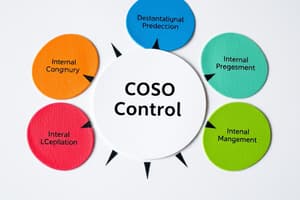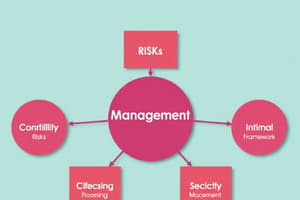Podcast
Questions and Answers
Why should management prioritize risks in risk management?
Why should management prioritize risks in risk management?
- To focus on risks that pose a significant threat to business objectives, as not all risks are of equal importance. (correct)
- To address each and every risk the company might face, ensuring complete coverage.
- To reduce costs, even if it means ignoring high-impact risks.
- To streamline the risk management process without considering the impact of various risks.
The COSO Enterprise Risk Management framework includes only internal components, disregarding external factors.
The COSO Enterprise Risk Management framework includes only internal components, disregarding external factors.
False (B)
What is the primary role of the 'internal environment' component in the COSO Enterprise Risk Management framework?
What is the primary role of the 'internal environment' component in the COSO Enterprise Risk Management framework?
The internal environment sets the tone of the company, influencing the risk and control consciousness of its people.
The top portion of the COSO cube highlights the four objectives of risk management: strategic, operational, __________, and compliance.
The top portion of the COSO cube highlights the four objectives of risk management: strategic, operational, __________, and compliance.
Match each risk response to its appropriate scenario:
Match each risk response to its appropriate scenario:
What is the ultimate goal of risk response planning?
What is the ultimate goal of risk response planning?
Inherent risk is the risk that remains after applying management's risk responses.
Inherent risk is the risk that remains after applying management's risk responses.
Why is it important for management to take a portfolio view of risks?
Why is it important for management to take a portfolio view of risks?
__________ activities are specific risk mitigation policies and procedures implemented throughout the organization to ensure risk responses are properly executed.
__________ activities are specific risk mitigation policies and procedures implemented throughout the organization to ensure risk responses are properly executed.
Match each type of control with its description:
Match each type of control with its description:
Why is information and communication a critical component of risk management?
Why is information and communication a critical component of risk management?
Ongoing monitoring and separate evaluations are mutually exclusive and cannot coexist within a risk management framework.
Ongoing monitoring and separate evaluations are mutually exclusive and cannot coexist within a risk management framework.
What should management do if significant deficiencies are identified during the monitoring of the risk management process?
What should management do if significant deficiencies are identified during the monitoring of the risk management process?
When assigning risk ratings, risks should be assessed in terms of __________ and impact.
When assigning risk ratings, risks should be assessed in terms of __________ and impact.
Match each qualitative risk rating with its description:
Match each qualitative risk rating with its description:
If a risk with high likelihood and high impact is identified, what is the appropriate risk response?
If a risk with high likelihood and high impact is identified, what is the appropriate risk response?
If the combined risk assessment is low, management must implement strict controls.
If the combined risk assessment is low, management must implement strict controls.
Provide three possible risk responses for risks that rated as 'high likelihood' and 'high impact'?
Provide three possible risk responses for risks that rated as 'high likelihood' and 'high impact'?
Residual risk is the risk that __________ after applying management's actions.
Residual risk is the risk that __________ after applying management's actions.
Match each component of the risk assessment template with the risk response:
Match each component of the risk assessment template with the risk response:
What is the main objective of monitoring and testing the risk management process?
What is the main objective of monitoring and testing the risk management process?
Monitoring the risk management process can only be done through ongoing activities, not through separate evaluations.
Monitoring the risk management process can only be done through ongoing activities, not through separate evaluations.
Deficiencies in the risk management process are reported to whom?
Deficiencies in the risk management process are reported to whom?
To reiterate, __________ risk is the risk that remains after applying management's actions.
To reiterate, __________ risk is the risk that remains after applying management's actions.
Match each risk-mitigating plan to the activity:
Match each risk-mitigating plan to the activity:
Internal control provides reasonable assurance that the objectives of the organization are __________.
Internal control provides reasonable assurance that the objectives of the organization are __________.
Internal control is an end in itself rather than a means toward achieving the objectives of the company.
Internal control is an end in itself rather than a means toward achieving the objectives of the company.
What does COSO stand for?
What does COSO stand for?
The COSO cube shows the three categories of internal control objectives, namely: effective and efficient operations; reliability of financial and nonfinancial __________; and compliance with applicable laws and regulations.
The COSO cube shows the three categories of internal control objectives, namely: effective and efficient operations; reliability of financial and nonfinancial __________; and compliance with applicable laws and regulations.
Flashcards
Risk Management
Risk Management
Addresses risks threatening business objectives.
Risk Prioritization
Risk Prioritization
Focus on significant threats to business objectives.
Risk Assessment Result
Risk Assessment Result
Determines appropriate risk response and controls.
Business Objectives
Business Objectives
Signup and view all the flashcards
Components of Risk Management
Components of Risk Management
Signup and view all the flashcards
Internal Environment
Internal Environment
Signup and view all the flashcards
Risk Awareness
Risk Awareness
Signup and view all the flashcards
Internal Environment
Internal Environment
Signup and view all the flashcards
Objective Setting
Objective Setting
Signup and view all the flashcards
Risk Appetite
Risk Appetite
Signup and view all the flashcards
Event Identification
Event Identification
Signup and view all the flashcards
Risk Assessment
Risk Assessment
Signup and view all the flashcards
Inherent Risk
Inherent Risk
Signup and view all the flashcards
Residual Risk
Residual Risk
Signup and view all the flashcards
Risk Response
Risk Response
Signup and view all the flashcards
Control Activities
Control Activities
Signup and view all the flashcards
Information and Communication
Information and Communication
Signup and view all the flashcards
Monitoring
Monitoring
Signup and view all the flashcards
Likelihood
Likelihood
Signup and view all the flashcards
Impact
Impact
Signup and view all the flashcards
Risk Assessment
Risk Assessment
Signup and view all the flashcards
Risk Map
Risk Map
Signup and view all the flashcards
Control Activities
Control Activities
Signup and view all the flashcards
Monitoring
Monitoring
Signup and view all the flashcards
Information and Communication
Information and Communication
Signup and view all the flashcards
Internal Control
Internal Control
Signup and view all the flashcards
Internal controls
Internal controls
Signup and view all the flashcards
Window dressing
Window dressing
Signup and view all the flashcards
Study Notes
- Risk management is vital, or businesses risk not achieving goals, risk managers need to know these vulnerabilities.
- Addressing every risk is too expensive, so prioritize significant risks.
- Risk assessment results determine risk response and controls, part of the COSO Enterprise Risk Management framework.
Components of COSO Enterprise Risk Management
- Framework is shown as the COSO Cube.
- Top highlights four objectives: strategic, operational, reporting, compliance.
- Front identifies eight components, applied across the enterprise.
- These components make up the risk management process which include; internal environment, objective setting, event identification, risk assessment, risk response, control activities, information & communication and monitoring
Internal Environment
- Reflects company's risk management philosophy, risk appetite, oversight, ethics, competence, authority, responsibility.
- It encompasses the "tone at the top" and influences governance, risk and control consciousness.
- The board and management must understand risks in order to oversee risk management effectively
- Actions like prioritizing risk management and providing resources show that the management team believes the risk is important, part of the company's risk management philosophy.
- Commitment and competence are part of it. The best process fails if people aren't competent.
- Personnel must have integrity and ethics.
Objective Setting
- A precondition to identifying, assessing ,and responding to risk. Without objectives, identifying risks becomes impossible
- Management sets strategic objectives for operational, reporting, and compliance objectives.
- These are formulated within the company's risk appetite, or acceptable risk level.
- Objectives must be in line with risk appetite by limiting strategic objectives that expose risk beyond the risk appetite. For example limiting the establishment of new branches based on debt ratio tolerance
Event Identification
- Managment identifies potential internal or external events that affect the company’s ability to achieve objectives, these may be positive or negative
- Negative events are risks, positive events are opportunities management channels them back to the objective setting process
- Identification may involve workshops, sessions, and brainstorming.
- The goal is to identify a comprehensive list of risks that may affect the company.
Risk Assessment
- Management assess different techniques and data to assess likelihood and impact, the assessments range from high, moderate or low.
- Inherent and residual risks will also be assessed, it is susceptibility of the company to a risk in the absence of any actions management might take to alter the risk’s likelihood or impact. These risks result from the nature of the company’s operation
- After applying management responses the risk that remains is residual risk
- Management must evaluate whether the residual risk is within the company’s risk appetite.
Risk Response
- Management considers options and their effect on risk likelihood and impact.
- The goal is to reduce residual risk to within tolerances.
- Planning determines risk mitigation policies and controls.
- Managment must be able to assess risk on an enterprise-wide basis across different functions, resulting in a a portoflio view of the risk
- Portofolio view enable managent to analyze enterprise-wide effects
Control Activities
- Management puts in place specific risk mitigation policies and procedures throughout the organization, at all levels and in all functions, for proper execution.
- Activities must be integrated with risk response, and the risk response must be integrated with risk assessment.
- The different control activity types such as preventive, detective, and corrective controls.
Information and Communication
- The company identifies, captures, and communicates pertinent information from internal and external sources so personnel can carry out their responsibilities.
- The personnel will not be able to correctly perform their function without correct internal and external communication, and inbound and outbound communication
Monitoring
- Ongoing activities and separate evaluations assess existence and effectiveness of risk management components and quality of performance over time.
- Management should evaluate a company objectives at an appropriate level, such as the entity or level of their business unit
- Internal auditors perform separate evaluations on a periodic basis, as well performing separate evaluations to help detect any significant deficiencies
Assigning Risk Ratings
- Identified risks are assessed in terms of likelihood and impact.
- Management is most concerned with risks that have "high" likelihood and "high" potential impact
- Inherent and residual risks will also be assessed, the likelihood is the proability of the occurence of an event
- Qualitative risk rating such as "high", "moderate", or "low" or with quantitative risk scores. (0 to 5)
Assessment of Impact
- Risk has a negative impact, but the potential consequence to profit, reputation, health, environment, or other critical factor vary.
- Impact pertains to the magnitude or consequence of the event or risk to the company.
- Impact can be assessed either qualitatively or quantitatively.
Risk Maps
- Assessments of likelihood and impact can be shown on the map
- Risk ratings can be plotted on the plot
- Color coding can be used depending on the levels of risks where significant risks are generally colored red
Combined Assessments and Risk Response
Risks on it can be interpreted as:
- Low likelihood / Low impact - Since the combined risk assessent is only low, management can ordinarily accept these risks
- High likelihood / High impact- Management should make sure that these risks are addressed through implementing risk mitigation plans and specific control activities
- High likelihood / Low impact and High impact / Low likelihood Management should still exert efforts in reducing these moderate risks
Documentation of the Risk Assessment, Risk Response, and Control Activities
- Management and employees have effectively carried out operations when revenue and operating cash flow targets are achieved
Limitations of Internal Control
- Even with a good risk matrix in the appropriate range, you can be affected by the following;
- Collusion
- Management override
- Human factors
- Cost-benefit considerations
Monitoring and Testing of the Risk Management Process
- Monitoring and testing of Risk Management is used to test effectiveness and determine risks are withing the company’s risk appetite
- Managment must monitor through these actions; ongoing monitoring activities, such as routine management reviews of the processes, separate evaluations, being done by internal auditiors
- Testing is conducted by Internal auditors which results in reporting any components, and its weakness to correct level of management , and to the directors
Studying That Suits You
Use AI to generate personalized quizzes and flashcards to suit your learning preferences.




